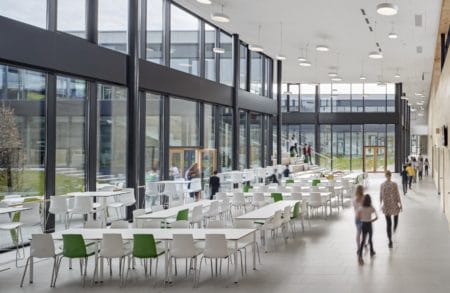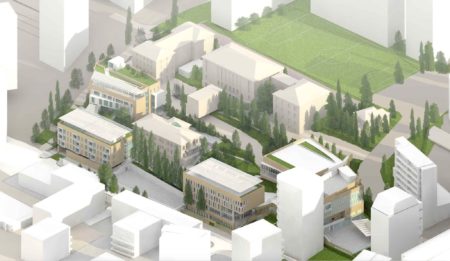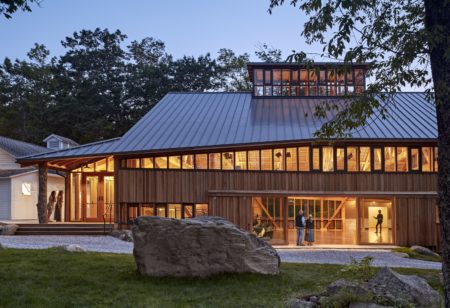IN THE MIDDLE OF A GLOBAL PANDEMIC, one Boston architecture firm, made an almost stunning instant transition to remote work. Despite having projects worldwide, intelligent technology decisions made as early as a decade before left Flansburgh Architects highly well-prepared for the uncertainty of 2020.
“It was Friday the 13th when the office called me and said we were going to go remote,” recounts Joe Marshall, AIA, senior associate at mid-sized Boston-based practice Flansburgh Architects. “I was already home because of my kids, and there were just two people—the receptionists and marketing—who had an iMac, and all we had to do was sync their computers over to a couple of laptops we had.”
We basically had no transition other than just not being together.
Flansburgh moved swiftly to a pandemic footing due in part to a series of technology decisions the firm made years before. Essentially everyone at the 28-person practice was already on a firm-provided Mac laptop. All their data had already been in the cloud, and the firm had set up Zoom as their full-suite communications system—meaning phone to virtual meetings. “The company just had to pay for increasing home Internet speeds,” says Brian Hores, AIA, architect and senior BIM Manager at Flansburgh. “We basically had no transition other than just not being together,” says Marshall.
While tens of thousands of other architecture firms worldwide went through painful technology adjustments to adapt to remote work, Flansburgh had some inherent advantages beyond their streamlined IT decisions. International practice made them agile many years prior.
Flansburgh—Their Work and History
Flansburgh, founded in 1963 in Boston, has always focused on academic architecture, and K-12 schools are their bread-and-butter projects. However, the award-winning architecture firm has expanded through the years to designing international schools abroad.

The American School of Zagreb, Croatia, winner of the 2019 Boston Society of Architects Honor Award for Design Excellence. (Image: Flansburgh / All rights reserved ) (click for larger image, typical)
The American International School of Zagreb, in Croatia, is a recent example. The project won a 2019 Boston Society of Architects (BSA) Honor Award for Design Excellence and consisted of 90,000 square feet of new structure with an Energy Performance Certificate (EPC) Certified A+. The firm has similar projects worldwide, from Beirut, Lebanon, to Guatemala City in Central American to Johannesburg, South Africa.
Flansburgh has developed advanced design competencies in academic building types, educational campus master planning, and similar specialty-type buildings like performance centers. “Our focus has been on serving mission-driven clients,” says Marshall. “Civic, cultural, and educational institutions are the types of clients that resonate with us—it’s rewarding to work on architecture that supports a non-profit mission.”
A Lean Tech Stack
The reader may be curious how a 28-person firm can handle such large projects on multiple continents with so few people. Joe Marshall explains that they are working with local architects of record with their foreign projects, and Flansburgh is the design architect. But in the US, the firm is usually the architect of record.

International College – Ras Beirut Elementary School, Beirut, Lebanon. (Image: Flansburgh / All rights reserved )
The firm is also highly organized and focused on gaining new efficiencies through a reasonably structured process. “Every year, we try to do an information technology initiative and a design technology initiative,” says Marshall, noting that the two are not the same thing. Moving their phone system to Zoom, for example, was an example of the former, so too was the decision to staff the entire office with Mac laptops. Building out their internal rendering pipeline from Vectorworks Architect to Twinmotion was an example of the latter type of initiative.

The International College Campus in Beirut, Lebanon, as a 3D BIM model generated in Vectorworks. (Image: Flansburgh / All rights reserved )
This A-B initiative process recalls the famous “tick-tock” rhythm of semiconductor development whereby a company like Intel would move its current chip architecture to a smaller manufacturing process technology (shrinking) known as the “tick” and follow that up with a new microarchitecture which introduced innovations known as the “tock.”
Our view is that technology is cheap. Our entire technology budget is like the cost of an employee.
Not wanting to stretch this analogy too far, Flansburgh’s design technology initiatives are akin to the “tock” stage wherein new technology formations using new tools provide the firm new capabilities (like the VR they are working on with The Wild). Similarly, the “tick” stage focuses on IT infrastructure and acceleration—propelling the firm’s design processes by making them inherently faster.

International College – Ras Beirut Elementary School, Beirut, Lebanon. (Image: Flansburgh / All rights reserved )
Marshall and Hores describe the mid-sized firm’s technology approach in lean terms, speaking about streamlining and keeping technology as simple as possible at first and allowing more complexity as warranted.
Technically, the firm utilizes Synology NAS technology in combination with prominent cloud storage providers in Dropbox and Google Drive. All of their data is synced automatically across multiple clouds and on-premise NAS units. The main office has a fiber backbone connection to the Internet, and the firm provides near fiber-level Internet speeds for employees at their homes.
“Our view is that technology is cheap. Our entire technology budget is like the cost of an employee,” says Marshall, who emphasizes that dedicated fiber for an office of 28 may sound like overkill, but as he says, “I would rather it be overkill than wasting people’s time.”

Jacob’s Pillow Dance, Perles Family Studio. Exterior view. (Image: Flansburgh / All rights reserved )
The same is true of hardware, where their tech-consultant configures what they call a “hero build” for their laptops. These intelligent technology decisions played essential roles in how the firm adapted to the global pandemic in 2020. When it was time to work from home, staff just took their MacBook computers with them at the end of the day like they do when flying to Europe or Africa for a meeting.
Flansburgh Architects has long been an all-Mac office. “The Mac was an early decision in our digital infrastructure, and we have never looked back,” says Marshall, who adds, “that is one of the reasons why we started with Vectorworks.”
next page: Lean and Agile — Vectorworks for BIM




Reader Comments
Comments for this story are closed